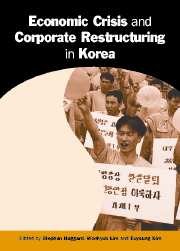Book contents
- Frontmatter
- Contents
- List of Figures
- List of Tables
- Preface and Acknowledgements
- Contributors
- A Note on Usage
- Abbreviations
- 1 Introduction: The Political Economy of Corporate Restructuring
- Part I The Politics and Economics of the Chaebol Problem
- Part II The Political Economy of Crisis Management
- Part III Reform and Restructuring
- Index
1 - Introduction: The Political Economy of Corporate Restructuring
Published online by Cambridge University Press: 05 July 2014
- Frontmatter
- Contents
- List of Figures
- List of Tables
- Preface and Acknowledgements
- Contributors
- A Note on Usage
- Abbreviations
- 1 Introduction: The Political Economy of Corporate Restructuring
- Part I The Politics and Economics of the Chaebol Problem
- Part II The Political Economy of Crisis Management
- Part III Reform and Restructuring
- Index
Summary
The financial crisis that swept through Asia in 1997-98 had many roots, but one that has received increasing attention is the nature of the Asian business group (Pomerleano 1998; Claessens, Djankov and Lang 2000b; Rajan and Zingales 1998; Johnson et al. 2000; Johnson and Mitton 2001). These highly diversified, family-owned conglomerates have been the entrepreneurial engine of Asia's rapid growth over the last three decades. But at the same time they exhibited a number of troubling weaknesses, from high leveraging to weak corporate governance, lack of transparency and outright corruption.
In no country in the region is this ambivalence about the business group more pronounced than Korea. Influential accounts of Korea's growth have put the Korean groups, or chaebol, at the very center of the country's economic transformation (Amsden 1989). Yet the chaebol's close and collusive ties with the government, increasing dominance of Korea's economy and oligopolistic practices also made them politically controversial (Cho 1990).These perceptions only strengthened with the financial crisis, for which many Koreans held the chaebol directly responsible.
This book offers a comprehensive overview of “the chaebol problem.” We look at the economic and political origins of the chaebol as a corporate form, their performance, and the role they played in the financial crisis of 1997-98. That crisis provided a powerful stimulus for reform of the financial system, the regulatory environment, and the chaebol themselves. The economics and politics of these reform efforts are the central focus of this book.
- Type
- Chapter
- Information
- Economic Crisis and Corporate Restructuring in KoreaReforming the Chaebol, pp. 1 - 32Publisher: Cambridge University PressPrint publication year: 2003
- 3
- Cited by



